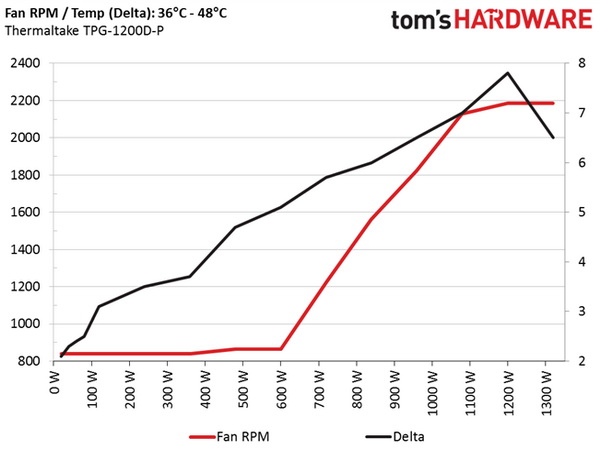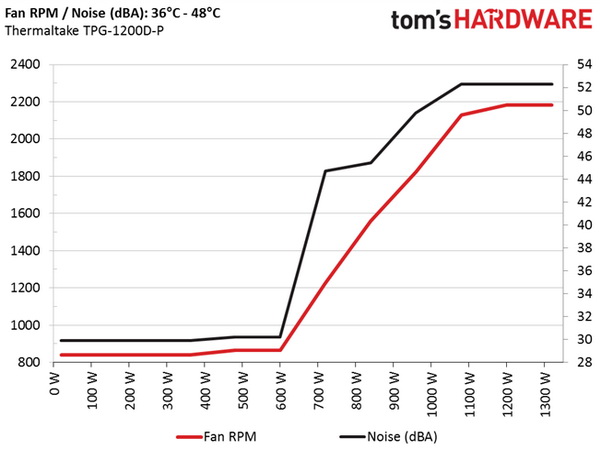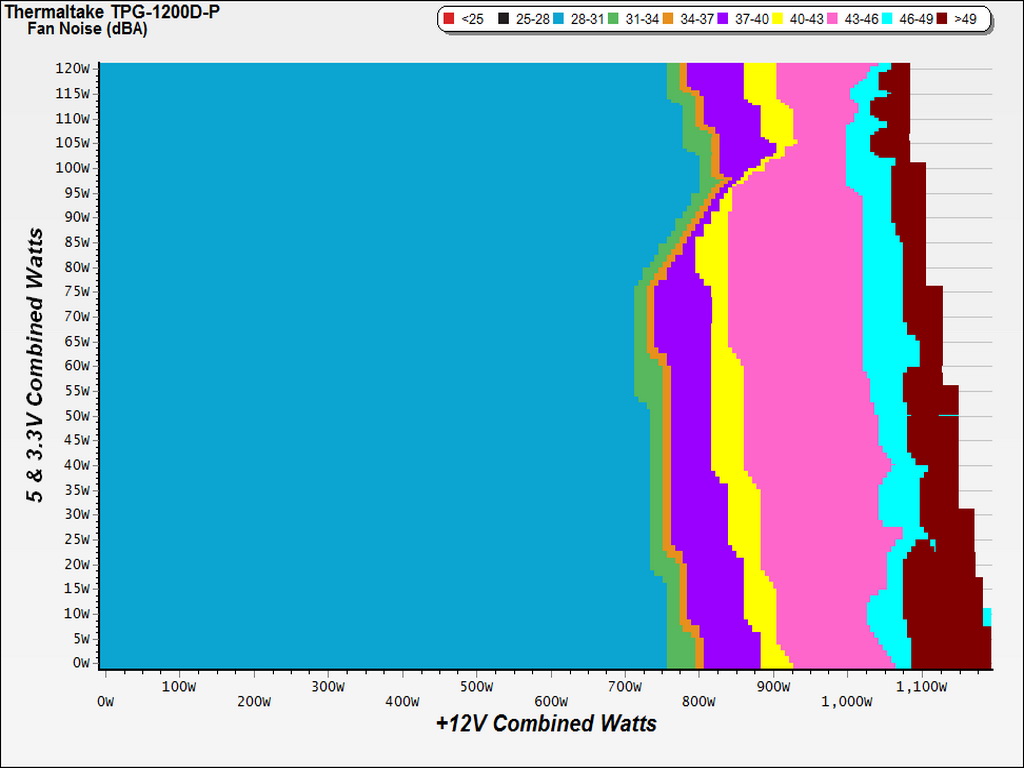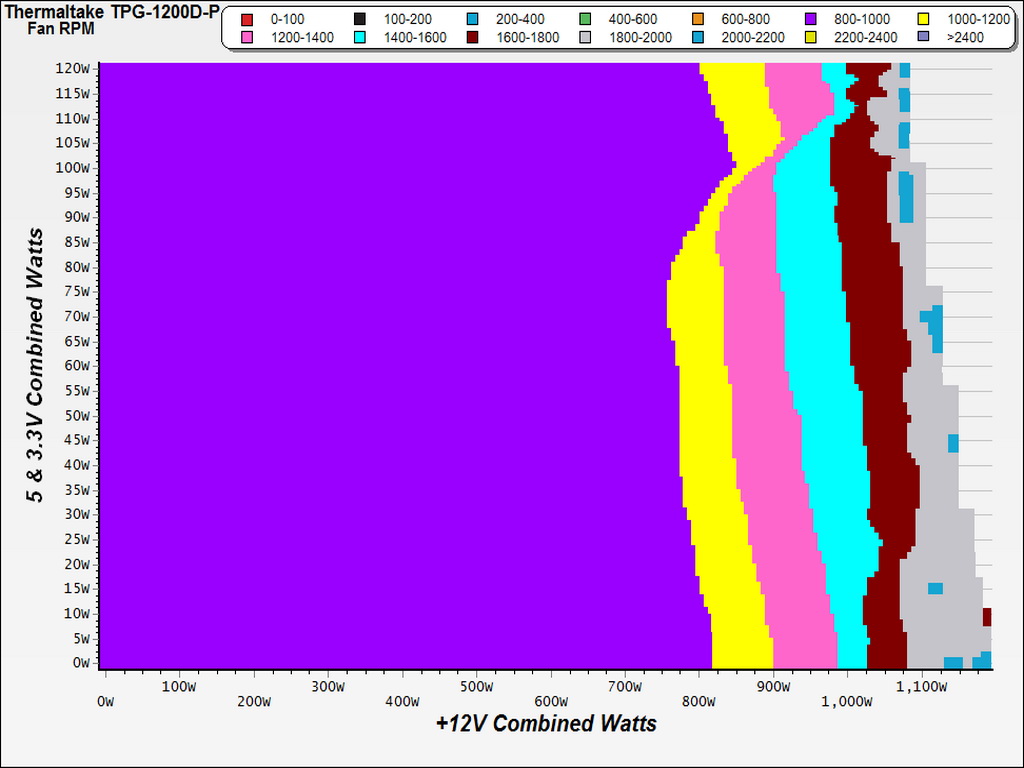Thermaltake Toughpower DPS G 1200W PSU Review
Thermaltake introduced the Toughpower DPS G Platinum line that consists of three new, semi-digital and fully modular PSUs made by Enhance Electronics. The highest-capacity 1200W model is our test subject in today's review.
Why you can trust Tom's Hardware
Efficiency, Temperature And Noise
Efficiency
Our efficiency testing procedure is detailed here.
Using the results from the previous page, we plotted a chart showing the TPG-1200D-P's efficiency at low loads, and loads from 10 to 110 percent of its maximum-rated capacity.
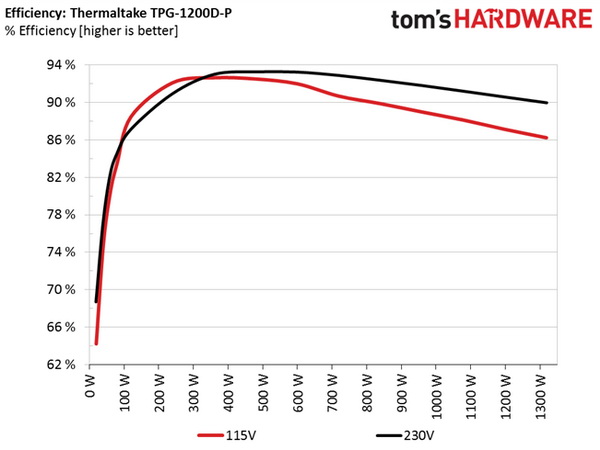
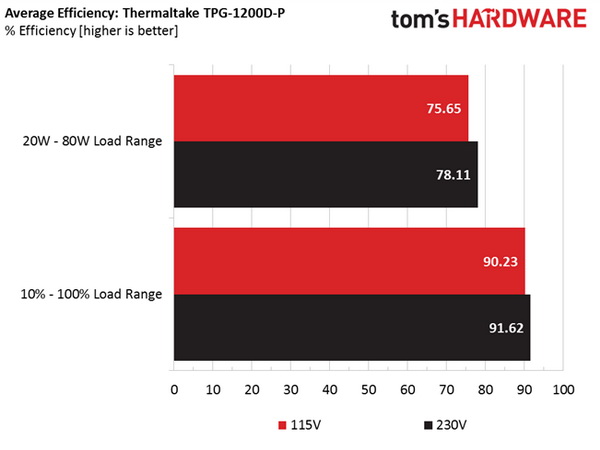
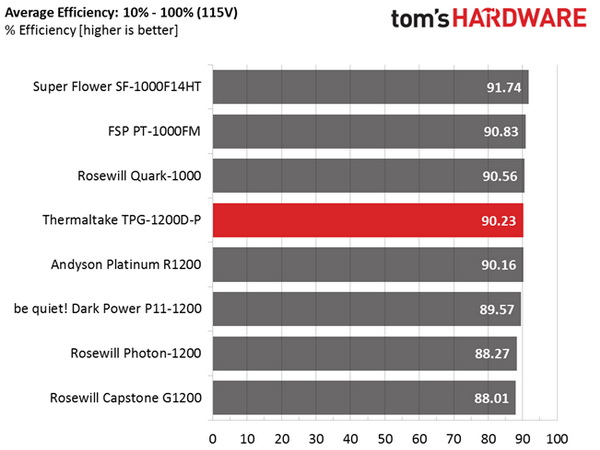
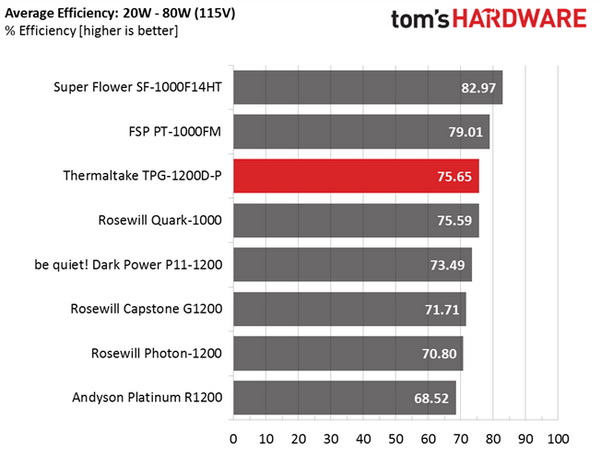
This is the first time we've seen a PSU achieving higher efficiency at light loads with 230V compared to 115V. We suspect this has something to do with the APFC's operation. The TPG-1200D-P matches most of the competition in this category under normal loads, and it registers decent efficiency under light loads where FSP's Platinum-rated solution and Super Flower's Titanium-class PSU leave the others far behind.
Efficiency At Low Loads
In the following tests, we measure the efficiency of the TPG-1200D-P at loads significantly lower than 10 percent of its maximum capacity (the lowest load the 80 PLUS standard measures). The loads we dialed were 20, 40, 60 and 80W. This is important for representing when a PC is idle, with power-saving features turned on.
| Test # | 12V | 5V | 3.3V | 5VSB | DC/AC (Watts) | Efficiency | Fan Speed (RPM) | Fan Noise | PF/AC Volts |
|---|---|---|---|---|---|---|---|---|---|
| 1 | 1.205A | 0.483A | 0.475A | 0.194A | 19.65 | 64.20% | 840 | 29.9 dB(A) | 0.841 |
| 12.121V | 5.103V | 3.350V | 5.098V | 30.61 | 115.1V | ||||
| 2 | 2.434A | 0.978A | 0.985A | 0.389A | 39.76 | 74.65% | 840 | 29.9 dB(A) | 0.900 |
| 12.118V | 5.101V | 3.347V | 5.093V | 53.26 | 115.1V | ||||
| 3 | 3.663A | 1.466A | 1.495A | 5.086A | 59.83 | 80.31% | 840 | 29.9 dB(A) | 0.934 |
| 12.116V | 5.097V | 3.343V | 5.086V | 74.50 | 115.1V | ||||
| 4 | 4.888A | 1.963A | 1.975A | 0.785A | 79.79 | 83.46% | 840 | 29.9 dB(A) | 0.931 |
| 12.113V | 5.093V | 3.339V | 5.079V | 95.60 | 115.1V |
The fan's noise is low. However, the same goes for efficiency during the first two tests. This is a high-capacity PSU though, so it's naturally out of its comfort zone at such low loads. This is why you shouldn't buy an oversized power supply if your PC's hardware doesn't need one.
DPSApp Screenshots
You'll find screenshots of the DPSApp software below, which we took during the light-load test sessions.
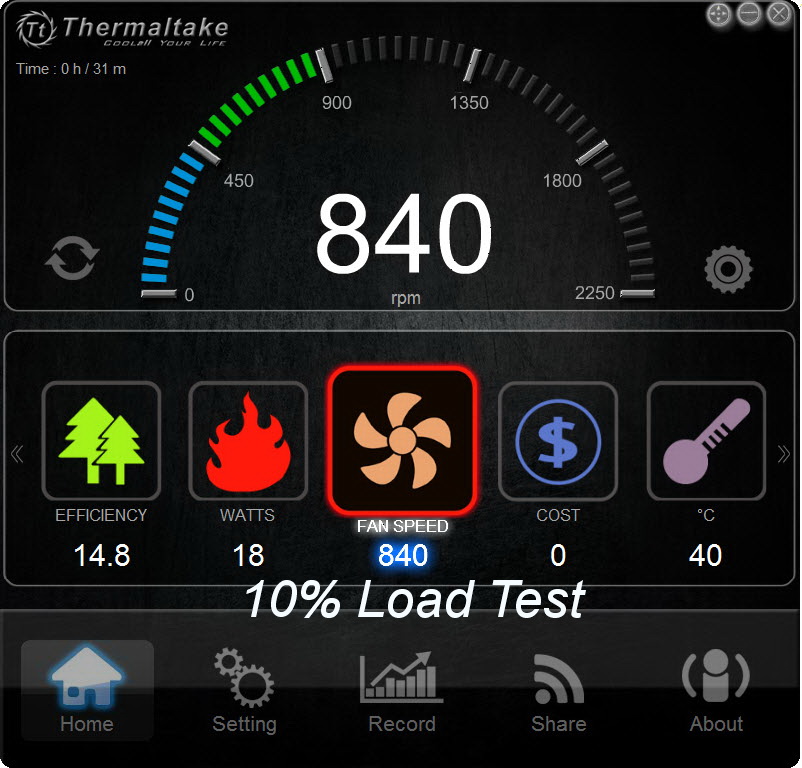

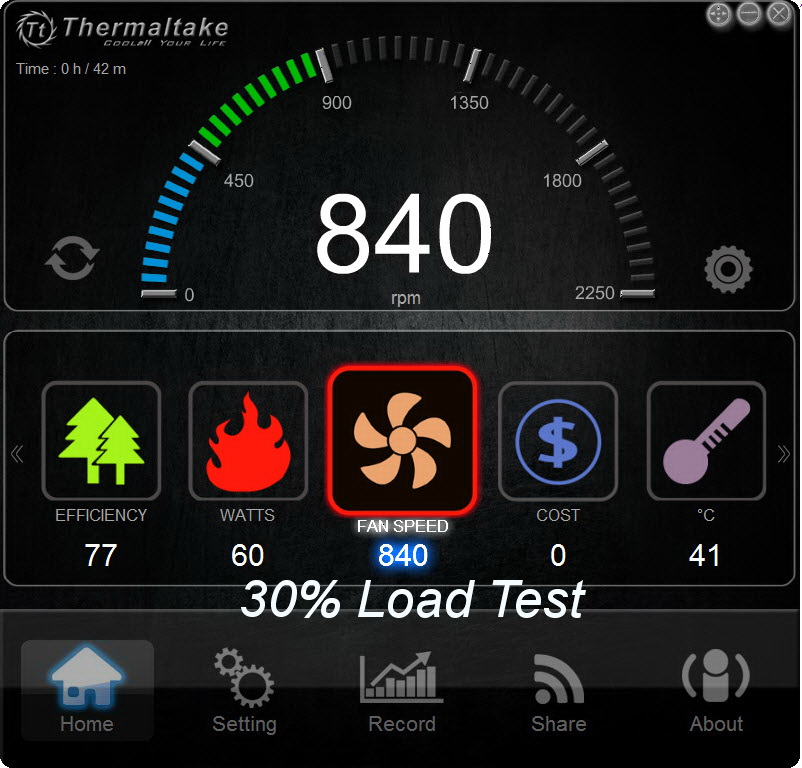
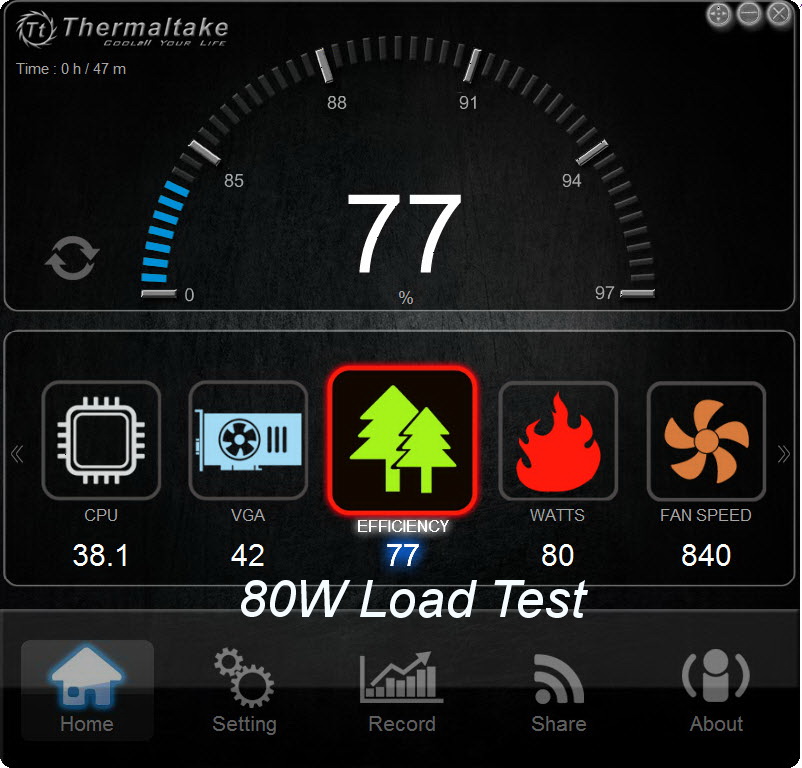
The power-out readings are accurate, but the efficiency results are way off.
Get Tom's Hardware's best news and in-depth reviews, straight to your inbox.
5VSB Efficiency
The ATX specification states that 5VSB standby supply efficiency should be as high as possible, recommending 50 percent or higher efficiency with 100mA of load, 60 percent or higher with 250mA of load and 70 percent or higher with 1A or more of load.
We take four measurements: one each at 100, 250 and 1000mA, and one with the full load the 5VSB rail can handle.
| Test # | 5VSB | DC/AC (Watts) | Efficiency | PF/AC Volts |
|---|---|---|---|---|
| 1 | 0.102A | 0.50 | 71.43% | 0.045 |
| 4.939V | 0.70 | 115.1V | ||
| 2 | 0.252A | 1.24 | 72.94% | 0.105 |
| 4.933V | 1.70 | 115.1V | ||
| 3 | 1.002A | 4.91 | 82.52% | 0.291 |
| 4.901V | 5.95 | 115.1V | ||
| 4 | 3.002A | 14.45 | 79.44% | 0.479 |
| 4.814V | 18.19 | 115.1V |
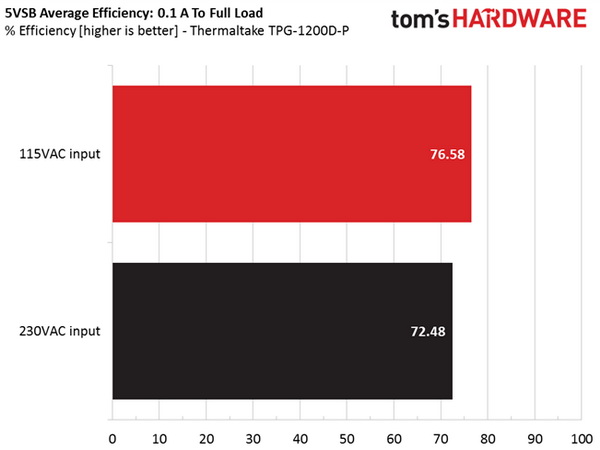
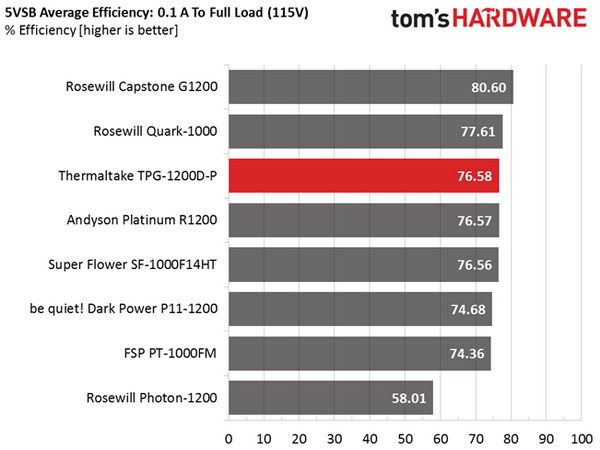
The 5VSB rail scores high efficiency readings, as you can see from the table above.
Power Consumption In Idle And Standby
In the table below, you'll find the power consumption and voltage values of all rails (except -12V) when the PSU is idle (powered on, but without any load on its rails), and the power consumption when the PSU is in standby mode (without any load, at 5VSB).
| Mode | 12V | 5V | 3.3V | 5VSB | Watts | PF/AC Volts |
|---|---|---|---|---|---|---|
| Idle | 12.123V | 5.109V | 3.354V | 5.110V | 6.08 | 0.256 |
| 115.1V | ||||||
| Standby | 0.07 | 0.004 | ||||
| 115.1V |
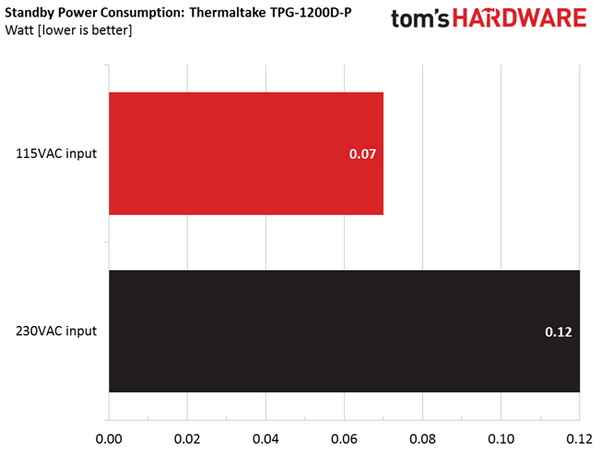
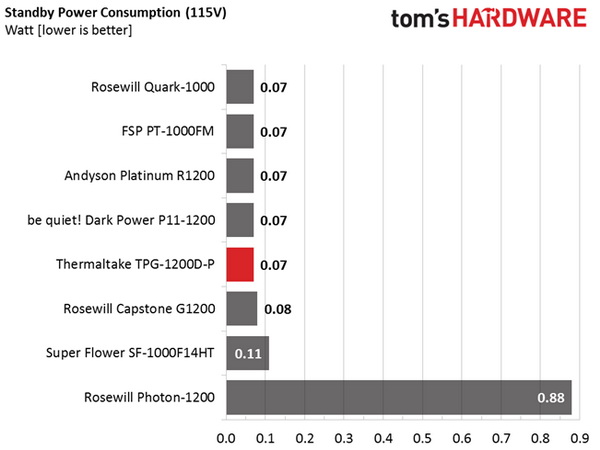
Phantom power is very low, which has a positive effect on the 5VSB rail's efficiency.
Fan RPM, Delta Temperature And Output Noise
Our mixed noise testing is described in detail here.
The first chart below illustrates the cooling fan's speed (in RPM), and the delta between input and output temperature. The results were obtained at 36 degrees C (96.8 degrees F) to 48 degrees C (118.4 degrees F) ambient temperature.
The next chart shows the cooling fan's speed (again, in RPM) and output noise. We measured acoustics from one meter away, inside a small, custom-made anechoic chamber with internals completely covered in sound-proofing material (be quiet! Noise Absorber kit). Background noise inside the chamber was below 18 dB(A) during testing, and the results were obtained with the PSU operating at 36 degrees C (96.8 degrees F) to 48 degrees C (118.4 degrees F) ambient temperature.
The following graph illustrates the fan's output noise over the PSU's operating range. The same conditions of the above graph apply to our measurements, though the ambient temperature was between at 28 degrees C (82.4 degrees F) to 30 degrees C (86 degrees F).
Up to around 780W, the PSU is fairly quiet for a high-capacity unit. This changes quickly above 900W though, and the fan gets very loud. It doesn't stop there; above 1100W, the fan exceeds 50 dB(A). If you push this PSU hard, invest in some earplugs.
The last graph depicts the fan's speed over the PSU's operating range. The ambient temperature during our measurements was between at 28 degrees C (82.4 degrees F) to 30 degrees C (86 degrees F).
Current page: Efficiency, Temperature And Noise
Prev Page Load Regulation, Hold-Up Time And Inrush Current Next Page Cross-Load Tests And Infrared Images
Aris Mpitziopoulos is a contributing editor at Tom's Hardware, covering PSUs.
-
Myrmidonas I do not see anywhere the limitation regarding the need of Flash Active X 15 and only that, in order the PSU's software DPSapp to operate. Is there anything changed? I own one of its little brothers the Toughpower 550W and on my system the DPSApp refuses to run on an Active X version higher than 15.In fact on the download page there is a note sayingReply
"※Note: The Adobe Flash Player ActiveX 20.0.0 version or above might NOT be compatible DPS G PC App."
http://www.thermaltake.com/dpsappdownload.aspx?type=dpsapp
or
"※Note: The DPS G PC App requires Adobe Flash Player Version 2.0.0.270 or above and Microsoft .NET Version 4.5 or above."
http://www.thermaltake.com/DPSGApp2download.aspx?type=dpsgapp2 -
TechyInAZ ReplyThis is a wimpy power supply. Bring on 5 KW units!
:lol: It would be great for litecoining machines. :) -
Aris_Mp hm I am not aware of this flash/directX issue. In my system I just installed the DPSApp and it ran fine. I have all updates installed. However this App still needs work and they should abandon the flash platform IMO.Reply -
Myrmidonas Reply18063833 said:hm I am not aware of this flash/directX issue. In my system I just installed the DPSApp and it ran fine. I have all updates installed. However this App still needs work and they should abandon the flash platform IMO.
In my case, I had no Flash on my system at all. I consider it dangerous and useless. But in order to operate DPSApp I first installed the latest version of Flash and the DPSApp crashes every time i try to open the GUI. Only on the v15 I manage to make it work. :sarcastic: -
TheUnhandledException ReplyPSUs in the >1kW range should deliver at least 3.5A-4A on 5VSB.
Why? It is the standby power? What modern system needs more than 15W standby? -
Aris_Mp it isn't the system that needs it, but the devices that you might try to charge through 5VSB when the PSU is in standby.Reply -
terroralpha so, there is absolutely no reason to buy this over the aging AX1200i or even the not-as-fancy HX1200i... in fact, if you buy this unit you either live in a country where corsair PSUs are hard to get or you are a moron.Reply
it failed the hold up requirement, regulation and ripple is mediocre at best, it's hideous and single rail designs really need to go from PSUs this powerful. 100 amperes is enough to arc weld! if the DSP malfunctions and send 100 amps down your motherboard or GPU, it'll set your house on fire. this isn't really a problem with old school analog designs. but with anything digitally controlled, bugs are always a concern.
AX1200i is a way better performer in pretty much every metric, has a 10 year warranty these days, and individually sleeved cables are relatively cheap and readily available.
